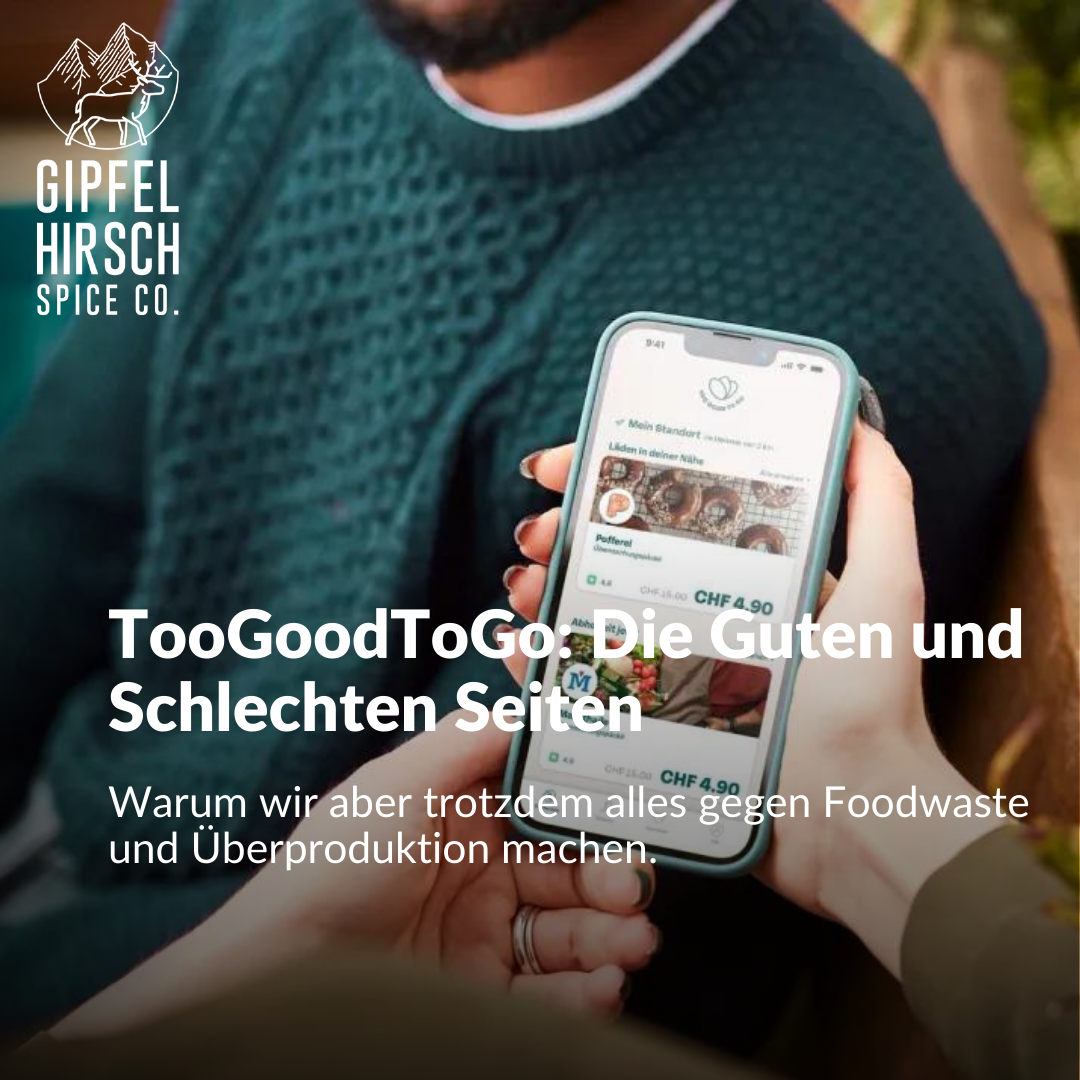
TooGoodToGo: Die Guten und Schlechten Seiten für uns als Firma
Also zu allererst: Wir sind bei TooGoodToGo mit dabei und werden es auch für die nächste Zeit bleiben - aus voller Überzeugung, dass wir damit auch die nicht mehr so schönen Produkte oder Produkte, die bald ablaufen, immer noch retten können. Bei uns findest du pure Gewürze (so wie Chilis, Salze, Pfeffer, Kräuter und andere Gewürze), Gewürzmischungen, Hotsauces oder auch mal eine Sirupmischung im Päckli.
Table of Contents
- Ist TooGoodToGo ein Pflaster für das eigentliche Problem?
- Kosten, Kosten, Kosten
- Gebühren auf Mitgliedschaft und auf Produkte?
- Das Business-Modell und Profit
- Zum Ende
Ist TooGoodToGo ein Pflaster für das eigentliche Problem?
Jetzt nehmen wir aber mal einen kleinen Schritt zurück und schauen uns an, was auf die Plattform kommt (wenigstens von Gipfelhirsch): Produkte, die bald ablaufen aber noch verkehrsfähig sind, Produkte aus einer Überproduktion oder auch Produkte, die einwandfrei sind und nur die Etiketten & Verpackungen nicht ganz perfekt sind, landen von uns als Überraschungspäckli auf TooGoodToGo. Wir bereiten diese Päckli einmal in der Woche vor und es findet eigentlich immer Anklang. Nur selten werden diese Päckli nicht komplett ausverkauft.
Es gibt nur ein Problem: Unser Ziel ist eigentlich weniger Ausschuss zu produzieren. Weniger Fehlproduktionen bedeuten auch immer weniger Abfall, geringerer Verbrauch und eine bessere Effizienz. Und mit dem Thema sind wir echt nicht schlecht aufgestellt. Das ist sozusagen ein Hobby von mir (Motzi), dass wir möglichst effektiv produzieren, damit ja nichts verschwendet wird. Das bedeutet aber auch, dass wir dadurch weniger Päckli vorbereiten können und einfach nichts zum Retten da ist.

Wir sind damit in einer eher unnormalen Situation. Nicht alle Businesses können so lean aufgebaut sein und einen gewissen Sicherheitspuffer braucht es halt auch. Eine Bäckerei könnte ja schliesslich auch nicht nur für jeden Kunden 'on-demand' ein frisches Sandwich belegen, und schon gar nicht, wenn das Brötchen jedes mal neu gebacken werden muss. Es gibt aber ganze Wissenschaften zu dem Thema und sie sind vor allem in den Auto-, Semiconductor-, Medical- Industrien vertreten: Lean, Six Sigma, Just in Time Production usw. Diese Konzepte können wir aber auch für uns im kleinen Rahmen nutzen, aber mit einem grossen Unterschied zu den Schwergewichten: das Kaufverhalten von Konsument:innen 😁.
Wenn es jetzt also ein Päckli mit unseren Produkten hat, dann kommt es nicht davon, dass wir schlecht geplant haben und viel zu viel abläuft, sondern auch oft, dass wir mal bessere Verkaufszahlen haben und manchmal halt auch nicht. Das Einkaufsverhalten vorherzusagen ist extrem schwierig und viele Faktoren zahlen darauf ein.
Kosten, Kosten, Kosten
So, jetzt schauen wir uns mal die Kosten und Preise an - TooGoodToGo ist eine B2B2C Plattform. Das heisst, dass die Plattform für Konsument:innen geschaffen ist (mit dem Ziel Foodwaste zu reduzieren) aber eigentlich der Umsatz von den Brands, die angebunden sind, kommt. Die Konsument:innen bekommen einen mega Deal - manchmal kann ich es selbst nicht glauben wie viel Ware im Päckli ist, wenn ich mal privat etwas über die App rette.
Aber irgendjemand musste ja die Ware auch einkaufen, die Qualität checken, produzieren, verpacken, transportieren und so weiter und so fort. Da entstehen Kosten und jetzt könnte man meinen, dass die Kosten ja vergeblich wären, wenn wir die Ware am Ende nur wegschmeissen und das ist auch komplett richtig! So einfach ist das Thema aber nicht. Da gibt es noch ein paar Nuancen, die uns einen leicht sauren Nachgeschmack bescheren:
- Um auf TooGoodToGo Überraschungspäckli hochzuladen, müssen wir eine jährliche Gebühr zahlen. Das zahlt für die Nutzung der Plattform, Zahlmethoden, Strom, Mitarbeiter, Marketing, usw.
- Die Plattform hat dann auch noch strikt definierte Anforderung was in den Päckli zum retten drin sein muss! Also basierend auf dem Produktwert. Hier ein Beispiel: Waren im Wert von mindestens CHF24 müssen im Päckli sein und dann kostet das Päckli auf TooGoodToGo CHF7.90. Also ein bisschen mehr als 3x billiger als der originale Preis.
So weit so gut. Jetzt könnte man meinen, dass die Brand diese knapp 8 Stutz bekommt um wenigstens die gröbsten Kosten auch zu retten - sozusagen ein Mehrwert für beide Partner dieser Transaktion.
Gebühren auf Mitgliedschaft und auf Produkte?
Obacht! das ist leider nicht ganz so. Von den CHF7.90 werden noch 2 Franken als weitere Gebühr abgezogen. Bei einer solchen Kalkulation müssen wir uns ernsthaft Gedanken machen, welche Verpackungen, Produkte und vor allem wie viel Ware dann in so einem Paket landen. Unsere Denke ist, dass wir doch wenigstens die Rohmaterial-Preise wieder reinbekommen sollten, damit wir dadurch den Verlust minimieren. Die Alternative Überlegung wäre ansonsten, dass wir doch lieber gleich die Waren verschenken. Das hätte den zusätzlichen Effekt, dass wir vielleicht als noch coolere Brand wahrgenommen würden; wer weiss?
Das Business-Modell und Profit
Vor kurzem haben wir ein Interview vom CEO Mette Lykke von TooGoodToGo auf Watson gelesen. Dort erzählt sie von der Traktion, vom Foodwaste und wie viel schon gerettet wurde - sehr inspierend! Die Kehrseite ist aber, dass viele Konsument:innen auch einfach mal nur auf Schnäppchensuche sind und das Ziel des Foodwaste reduzieren gar nicht immer an vorderster Stelle steht. Und dann kommt noch die Profitabilität von der Plattform. Mette wollte dazu nichts sagen, aber, dass ihr Umsatz im letzten Jahr um 42% gestiegen ist.
Zum Ende
TooGoodToGo hat ein sehr nobles Ziel und wir unterstützen das zu 100% - Wir als Firma, als Private und Konsumenten müssen mehr daran denken weniger Überschuss zu generieren und effizienter mit unseren Materialien umzugehen. Und was man dann noch retten und weiterhin konsumieren kann, machen wir auch.
Nur ist die Kostenstruktur so knapp aufgebaut, dass wir nicht mehr dieses 'warm fuzzy Feeling' haben, wenn es darum geht Produkte zu retten. Wir könnten sie ja dann gleich verschenken...
Was meint ihr dazu? Habt ihr Anregungen? Eine andere Meinung? Lasst es uns in den Kommentaren wissen.

